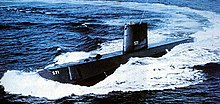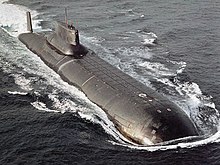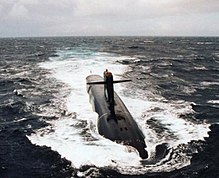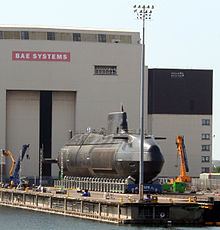|
Nuclear submarine
A nuclear submarine is a submarine powered by a nuclear reactor, but not necessarily nuclear-armed. In the US classification, nuclear-powered submarines are designated as SSxN, where the SS denotes submarine, x=G means that the submarine is equipped with guided missiles (usually cruise missiles), x=B means that the submarine is equipped with ballistic missiles (usually intercontinental) and the N means that the submarine is nuclear-powered. SSN refers to nuclear-powered attack submarines, which do not carry missiles. Nuclear submarines have considerable performance advantages over "conventional" (typically diesel-electric) submarines. Nuclear propulsion, being completely independent of air, frees the submarine from the need to surface frequently, as is necessary for conventional submarines. The large amount of power generated by a nuclear reactor allows nuclear submarines to operate at high speed for long periods, and the long interval between refuelings grants a virtually unlimited range, making the only limits on voyage times factors such as the need to restock food or other consumables.[2] Thus nuclear propulsion solves the problem of limited mission duration, that all electric (battery or fuel cell powered) submarines face. The high cost of nuclear technology means that relatively few of the world's military powers have fielded nuclear submarines. Radiation incidents have occurred within the Soviet submarines, including serious nuclear and radiation accidents, but American naval reactors starting with the S1W and iterations of designs have operated without incident since USS Nautilus (SSN-571) launched in 1954.[3][4] History  The idea for a nuclear-powered submarine was first proposed in the United States Navy by the Naval Research Laboratory's physicist Ross Gunn in 1939.[5] The Royal Navy began researching designs for nuclear propulsion plants in 1946.[6] Construction of the world's first nuclear-powered submarine was made possible by the successful development of a nuclear propulsion plant by a group of scientists and engineers in the United States at the Naval Reactors Branch of the Bureau of Ships and the Atomic Energy Commission. In July 1951, the U.S. Congress authorized construction of the first nuclear-powered submarine, Nautilus, under the leadership of Captain Hyman G. Rickover, USN (sharing a name with Captain Nemo's fictional submarine Nautilus in Jules Verne's 1870 novel Twenty Thousand Leagues Under the Seas, the first demonstrably practical submarine Nautilus, and another USS Nautilus (SS-168) that served with distinction in World War II).[citation needed] The Westinghouse Corporation was assigned to build its reactor. After the submarine was completed at the Electric Boat Company, First Lady Mamie Eisenhower broke the traditional bottle of champagne on Nautilus' bow, and the submarine was commissioned USS Nautilus (SSN-571), on 30 September 1954.[7] On 17 January 1955, she departed Groton, Connecticut, to begin sea trials. The submarine was 320 feet (98 m) long and cost about $55 million. Recognizing the utility of such vessels, the British Admiralty formed plans to build nuclear-powered submarines.[8] The Soviet Union soon followed the United States in developing nuclear-powered submarines in the 1950s. Stimulated by the U.S. development of Nautilus, Soviets began work on nuclear propulsion reactors in the early 1950s at the Institute of Physics and Power Engineering, in Obninsk, under Anatoliy P. Alexandrov, later to become head of the Kurchatov Institute. In 1956, the first Soviet propulsion reactor designed by his team began operational testing. Meanwhile, a design team under Vladimir N. Peregudov worked on the vessel that would house the reactor. After overcoming many obstacles, including steam generation problems, radiation leaks, and other difficulties, the first nuclear submarine based on these combined efforts, K-3 Leninskiy Komsomol of the Project 627 Kit class, called a November-class submarine by NATO, entered service in the Soviet Navy in 1958.[9] The United Kingdom's first nuclear-powered submarine HMS Dreadnought was fitted with an American S5W reactor, provided to Britain under the 1958 US-UK Mutual Defence Agreement. The hull and combat systems of Dreadnought were of British design and construction, although the hull form and construction practices were influenced by access to American designs.[6] During Dreadnought's construction, Rolls-Royce, in collaboration with the United Kingdom Atomic Energy Authority at the Admiralty Research Station, HMS Vulcan, at Dounreay, developed a completely new British nuclear propulsion system. In 1960, the UK's second nuclear-powered submarine was ordered from Vickers Armstrong and, fitted with Rolls-Royce's PWR1 nuclear plant, HMS Valiant was the first all-British nuclear submarine.[10] Further technology transfers from the United States made Rolls-Royce entirely self-sufficient in reactor design in exchange for a "considerable amount" of information regarding submarine design and quietening techniques transferred from the United Kingdom to the United States.[11][12] The rafting system for the Valiant class provided the Royal Navy with an advantage in submarine silencing that the United States Navy did not introduce until considerably later.[13] Nuclear power proved ideal for the propulsion of strategic ballistic missile submarines (SSB), greatly improving their ability to remain submerged and undetected. The world's first operational nuclear-powered ballistic missile submarine (SSBN) was USS George Washington with 16 Polaris A-1 missiles, which conducted the first SSBN deterrent patrol November 1960 – January 1961. The Soviets already had several SSBs of the Project 629 (Golf class) and were only a year behind the US with their first SSBN, ill-fated K-19 of Project 658 (Hotel class), commissioned in November 1960. However, this class carried the same three-missile armament as the Golfs. The first Soviet SSBN with 16 missiles was the Project 667A (Yankee class), the first of which entered service in 1967, by which time the US had commissioned 41 SSBNs, nicknamed the "41 for Freedom".[14][15]  At the height of the Cold War, approximately five to ten nuclear submarines were being commissioned yearly from the four Soviet submarine yards (Sevmash in Severodvinsk, Admiralteyskiye Verfi in St. Petersburg, Krasnoye Sormovo in Nizhny Novgorod, and Amurskiy Zavod in Komsomolsk-on-Amur). From the late 1950s through the end of 1997, the Soviet Union, and later Russia, built a total of 245 nuclear submarines, more than all other nations combined.[17] Today, six countries deploy some form of nuclear-powered strategic submarines: the United States, Russia, the United Kingdom, France, China, and India.[18] Several other countries including Brazil and Australia[19][20] have ongoing projects in various phases to build nuclear-powered submarines. In the United Kingdom, all former and current nuclear submarines of the British Royal Navy (with the exception of three: HMS Conqueror, HMS Renown and HMS Revenge) have been constructed in Barrow-in-Furness (at BAE Systems Submarine Solutions or its predecessor VSEL) where construction of nuclear submarines continues. Conqueror is[update] the only nuclear-powered submarine in the world ever to have engaged an enemy ship with torpedoes, sinking the cruiser ARA General Belgrano with two Mark 8 torpedoes during the 1982 Falklands War. TechnologyThe main difference between conventional submarines and nuclear submarines is the power generation system. Nuclear submarines employ nuclear reactors for this task. They either generate electricity that powers electric motors connected to the propeller shaft or rely on the reactor's heat to produce steam that drives steam turbines (cf. nuclear marine propulsion). Reactors used in submarines typically use highly enriched fuel (often greater than 20%) to enable them to deliver a large amount of power from a smaller reactor and operate longer between refuelings – which are difficult due to the reactor's position within the submarine's pressure hull. Also, virtually all nuclear reactors employed in submarines so far have been of the pressurized light-water reactor type.[21] The nuclear reactor also supplies power to the submarine's other subsystems, such as for maintenance of air quality, fresh water production by distilling salt water from the ocean, temperature regulation, etc. All naval nuclear reactors currently in use are operated with diesel generators as a backup power system. These engines are able to provide emergency electrical power for reactor decay heat removal, as well as enough electric power to supply an emergency propulsion mechanism. Submarines may carry nuclear fuel for up to 30 years of operation. The only resource that limits the time underwater is the food supply for the crew and maintenance of the vessel. The stealth technology weakness of nuclear submarines is the need to cool the reactor even when the submarine is not moving; about 70% of the reactor output heat is dissipated into the sea water. This leaves a "thermal wake", a plume of warm water of lower density which ascends to the sea surface and creates a "thermal scar" that is observable by thermal imaging systems, e.g., FLIR.[22] Another problem is that the reactor is always running, creating steam noise, which can be heard on sonar, and the reactor pump (used to circulate reactor coolant), also creates noise, as opposed to a conventional submarine, which can move about on almost silent electric motors.[citation needed] DecommissioningThe useful lifetime of a nuclear submarine is estimated to be approximately 25 to 30 years, after this period the submarine will face fatigue and corrosion of components, obsolescence and escalating operating costs.[23][24] The decommissioning of these submarines is a long process; some are held in reserve or mothballed for some time and eventually scrapped, others are disposed of immediately.[25][24] Countries operating nuclear submarines have different strategies when it comes to decommissioning nuclear submarines.[26] Nonetheless, the effective disposal of nuclear submarines is costly, in 2004 it was estimated to cost around 4 billion dollars.[27][28] MethodsGenerally there are two options when it comes to decommissioning nuclear submarines. The first option is to defuel the nuclear reactor and remove the material and components that contain radioactivity, after which the hull section containing the nuclear reactor will then be cut out of the submarine and transported to a disposal site for low-level radioactive waste and get buried according to waste procedures.[24] The second option is to defuel the nuclear reactor, disassemble the submarine propulsion plant, install vents in the nonreactor compartments and fill the reactor compartment.[23][24] After sealing the submarine it can then be towed to a designated deep-sea disposal site, be flooded and settle intact on the sea floor.[24] This last option has been considered by some navies and countries in the past.[29] However, while sea disposal is cheaper than land disposal the uncertainty regarding regulations and international law, such as the London Dumping Convention and the Law of the Sea Convention, has stopped them from proceeding with this option.[29] LineageOperationalUnited States Navy[30]
 Under development
Soviet/Russian Navy
 Under development
Royal Navy (United Kingdom)
 Under development
French Navy
 Under development
Chinese People's Liberation Army Navy
 Under development
Indian Navy
 Under development
Brazilian NavyUnder development
Royal Australian NavyPlans to purchase Under development DecommissionedUnited States Navy
Soviet/Russian Navy
Royal Navy (United Kingdom)
French NavyIndian Navy
AccidentsReactor accidentsSome of the most serious nuclear and radiation accidents by death toll in the world have involved nuclear submarine mishaps. To date, all of these were units of the former Soviet Union.[3][4][44] Reactor accidents that resulted in core damage and release of radioactivity from nuclear-powered submarines include:[3][45]
Other major accidents and sinkings
New technological developmentsIt has been reported that the Russian Navy plans to introduce in 2027 a nuclear-powered nuclear-armed unmanned underwater vehicle named Poseidon.[52][53] Limited data available in open literature suggests that it uses a small (mostly likely enriched uranium-fueled) reactor, and it is capable or travelling at a fairly high speed of 130 km/h, although for most of its mission duration it is expected to travel much slower to avoid acoustic detection. It is expected to be launched from specially-designed Belgorod class submarines, and to hit large coastal cities as a second strike weapon. (Although the initial tests of Poseidon were conducted with a diesel-electric submarine Sarov). The main advantage of using unmanned underwater vehicles instead of SSBNs as a second strike weapon is to prevent the loss of lives of the SSBN crew. If the second strike nuclear missiles are launched directly from an SSBN, the location of the submarine is revealed and it can be quickly destroyed in a third strike by a cruise or ballistic missile, launched from another submarine, from a surface ship or from land. When an UUV delivers a nuclear charge, the location of the mothership remains unknown, and the ship is likely to survive the 3rd strike. No other country is known to be developing similar weapons in 2024.[54] In the meantime, the United States is developing Columbia-class submarines. It is expected to have 16 missile tubes and to have its first patrol missing in 2031. Twelve submarines of this class, with a service life of ca. 42 years, are expected to be commissioned.[55] See also
NotesCitations
References
Further reading
External linksWikimedia Commons has media related to Nuclear submarines.
|
||||||||||||



